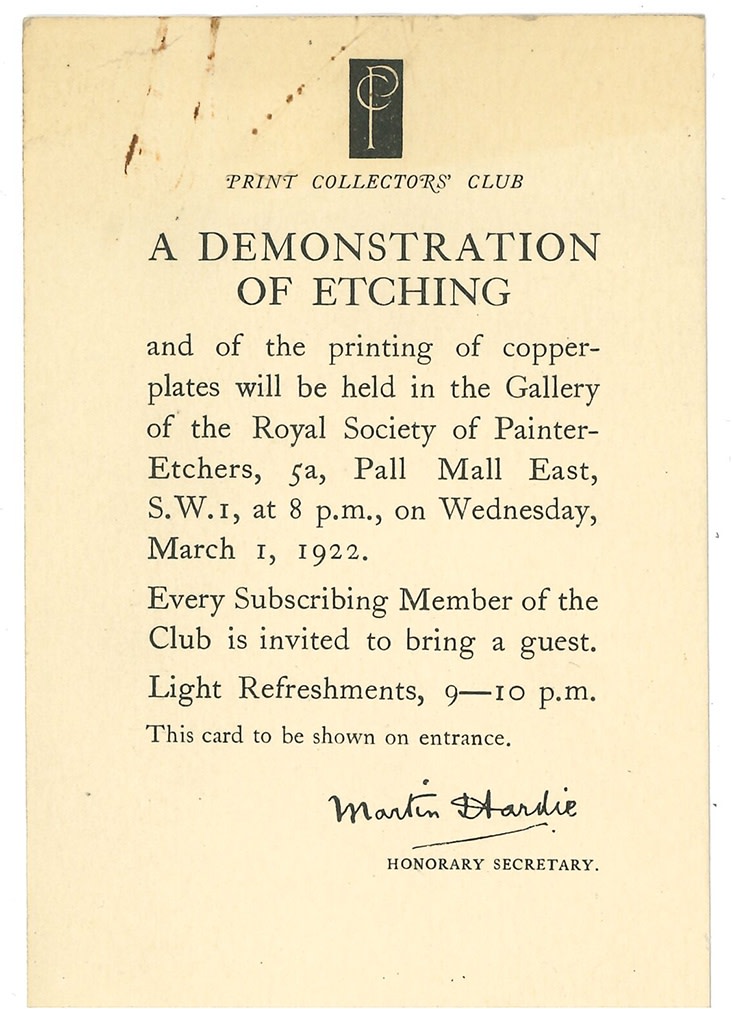The History of the Print Collectors Club
The Print Collectors Club (PCC) was established by the Royal Society of Painter-Printmakers in the 1920’s, as a result of the ‘Etching Boom’ which occurred in Britain and America immediately after the First World War when the public developed a particular love of etchings. This translated into a strong market: prints were traded between collectors, in galleries and auction houses as if they were oil, sugar or gold commodities on the stock market.

A PCC membership brochure from the RE archives
The concept of the PCC was the brain-child of the then President of the RE, Sir Frank Short. At this time, he was also Professor of Printmaking at the Royal College of Art, as well as being a Royal Academician. Short cared passionately that original prints should been seen and valued equally to painting, drawing and sculpture. The first PCC Chairperson was Martin Hardie CBE, then RE Hon Secretary and Keeper of Prints & Drawings at the V&A. Through the PCC, both Short and Hardie relished sharing their expert knowledge, personal (considerably sized) print collections and love of original printmaking with the public.
In 1920, the first PCC committee set out its objective of this Club as,
‘to bring people, who are interested in original printmaking, into closer connection with those who practice the art, to promote general knowledge of all forms of printmaking, and to furnish Print Collectors’ Club members with the opportunity of obtaining expert advice on prints.’

Invitation to a PCC Demonstration of Etching
at the RE’s then home, 5a Pall Mall, 1922
Take a look through this leaflet from another PCC demonstration in etching, from 1926
The PCC quickly had a sizeable membership and lectures, demonstrations and discussions on prints were held defiantly even during the dark evenings of the Blitz in the early 1940’s. The PCC generated revenue enabling the production of a brilliant series of insightful books on prints, printmaking and printmakers. The annual PCC lecture, given by a leading authority at one of the Club Meetings, was also generally published by the Society.

This letter to PCC members from 1925, explains that each member is sent a reproduction of each of that year’s presentation prints (effectively a catalogue), alongside their original Presentation print, which had been allocated to them. They then were offered the chance to swap their Presentation print with other club members if they wished to.
In the earlier days of the Club, members paid their membership fee, which in 1921 was 3 guineas, and this entitled them to one of the annual presentation prints. These presentation prints were exclusively available to members of the PCC. Along with their membership, they had access to all the PCC demonstrations and lectures, expert advice on print works and any publications issued by the PCC.
As the way people purchase artwork and receive information has evolved much over the last 100 years, so has the club. RE events and talks are now largely free of charge, as is entry to RE exhibitions at its home at London’s Bankside Gallery.
From 1924 one print from each edition of every PCC print has been presented to the Print Rooms of the Victoria & Albert Museum for their permanent collection resulting in leading printmakers in the Society being represented in the national collection. These include past RE printmakers of international renown such as Julian Trevelyan, Dame Laura Knight, Ann Le Bas, Anthony Gross, Stanley Anderson, Oliver Hall, Frederick Griggs, Paul Drury, Dorothy Woollard, Stanley William Hayter, Clare Leighton, Robert Austin, Valerie Thornton, Charles Tunnicliffe and Robin Tanner, to name just a few. Each of these created a specially dedicated composition for the PCC and so now feature in this collection at the V&A, as do all the works in this new 2022 PCC collection.

The 2023 PCC Collection of Prints
L-R top to bottom: Ade Adesina ARE, Anne Desmet RA RE (detail), Terence Gravett ARE,
Stephen Lawlor ARE, Katya Timoshenko ARE, Jane Walker ARE
Read more about these artworks on the PCC page